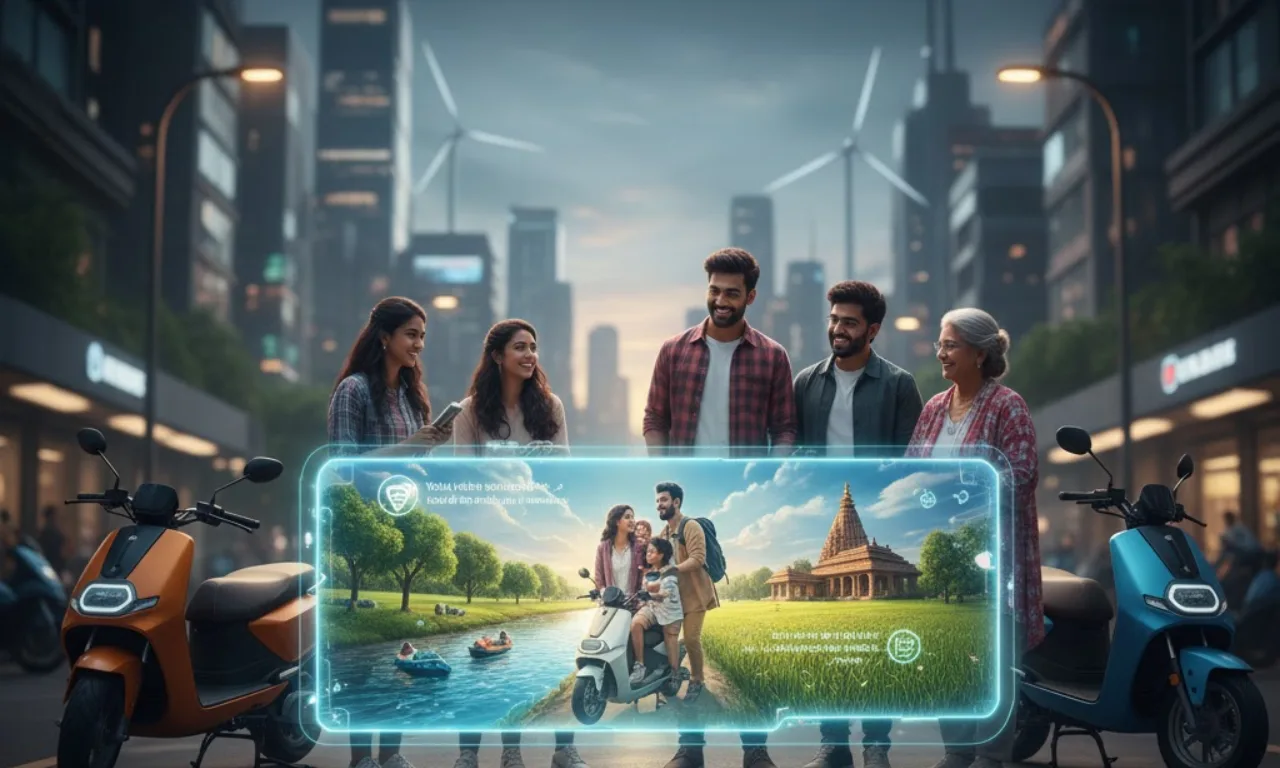Creative Storytelling: Selling More Than Specs

EV brands often lead with specs range, torque, charge time, efficiency. But buyers rarely remember numbers; they remember feelings.
In the EV industry in India, where dozens of new models compete on similar performance metrics, what differentiates one brand from another isn’t what’s under the hood it’s what’s in the story.
Creative storytelling turns mobility into meaning. It transforms EVs from machines into symbols of innovation, identity, and responsibility.
The most successful OEMs today Ather, Tata, and BYD aren’t selling batteries; they’re selling belonging.
Why Specs Don’t Sell, Stories Do
A spec sheet tells people what a vehicle is. A story tells them why it matters.
Data creates awareness; emotion creates action. Research by GrowthJockey’s marketing intelligence team shows that EV ads with human-centered storytelling achieve 4× higher engagement and 2.5× higher conversion compared to feature-focused content.
The reason? Customers see EVs not just as mobility choices, but as statements of intentfor sustainability, progress, and modernity.
1. Define the “Why” Before the “What”
Before designing a campaign or tagline, define the core emotion your brand wants to evoke.
For Ather, it’s intelligence.
For Tata, it’s trust.
For Ola Electric, it’s disruption.
A clear emotional anchor shapes everything—from visuals to messaging tone. If your audience doesn’t feel something, they won’t remember anything.
A great EV story doesn’t explain specifications; it explains significance.
2. Shift from Promotion to Participation
The next generation of EV consumers doesn’t want to be marketed _to they want to be marketed with. Storytelling in this new era is participatory.
Invite customers, employees, and dealers to co-create stories:
-
Document user journeys how their first EV changed their commute or business.
-
Spotlight technicians or factory workers contributing to the clean-tech shift.
-
Feature local charging stories that humanize the ecosystem.
When storytelling becomes collaborative, brand ownership turns into brand advocacy.
3. Turn Data Into Emotion
EVs generate massive data—kilometers driven, carbon saved, battery life, charging cycles. But raw data means little unless it’s humanized.
Translate metrics into meaning:
-
“You saved 250 kg of CO₂ this month—enough to offset 30 trees.”
-
“Together, our riders have traveled 1 million emission-free kilometers.”
This storytelling formula—data + emotion + purposeconverts information into inspiration.
4. Use Multi-Sensory Storytelling
EVs are silent, smooth, and smart qualities that deserve equally creative expression.
Incorporate visuals, motion, and sound to bring stories alive:
-
Crisp visuals of urban mobility and open highways.
-
Subtle soundscapes of energy transition and technology in motion.
-
Cinematic storytelling on social platforms that highlight the feeling of driving electric.
Remember: storytelling is not about communication it’s about experience design.
5. Spotlight Humans, Not Hardware
Most EV campaigns feature vehicles in perfect studio light. But the real heroes are people drivers, dealers, engineers, and dreamers powering the ecosystem.
Human stories build relatability and reinforce trust. A 60-second story about a delivery rider switching to electric can outperform a ₹10-lakh media campaign on efficiency specs.
The brand that tells stories of humans leading change becomes the one customers root for.
6. Design Localized Narratives
India’s EV revolution is regional before it’s national. Customer mindsets in Bengaluru differ from those in Bhopal or Bhubaneswar.
Use local dialects, regional influencers, and community voices to build micro-stories that travel faster and stick longer. Localization isn’t translation, it’s empathy at scale.
By tailoring stories to local realities (fuel prices, power reliability, community pride), EV brands create deeper cultural resonance.
7. Integrate Storytelling into Dealer and Sales Operations
The most overlooked storytelling channel in the EV value chain is the dealer.
Sales teams often rely on spec-based pitches that don’t connect emotionally with buyers.
With **Ottopilot **, OEMs can transform dealership storytelling. Ottopilot is a business operating solution that helps manage dealers, sales teams, and corporate operationswhile ensuring marketing messages remain consistent across every touchpoint.
When dealers tell the same story as the brand, customer trust compounds across the network.
8. Make Storytelling Measurable
Creativity is powerful, but credibility comes from measurement.
Use tools like Intellsys.ai to analyze how storytelling influences brand perception, engagement, and conversion.
Track:
-
Content performance by audience segment.
-
Sentiment and keyword trends across platforms.
-
Lead and referral uptick post-campaign.
When storytelling becomes data-informed, marketing evolves from art to architecture.
The GrowthJockey View: Stories That Scale
At GrowthJockey, we believe the future of automotive marketing lies in stories that scale—emotionally and operationally. A brand’s story should travel from boardroom to showroom, from media to CRM, without losing its soul.
Through Intellsys.ai, we empower OEMs to map sentiment, narrative reach, and ROI in real time.
With Ottopilot, we ensure that the same brand emotion translates seamlessly into dealer performance, sales experiences, and customer engagement.
This is how creative storytelling becomes a system one that powers trust, advocacy, and lifetime value.
GrowthJockey is a venture architect for enterprises, helping OEMs and EV startups scale credibility and growth through creative, data-driven storytelling.
We integrate brand strategy, analytics, and business operations to transform marketing from campaigns into ecosystems.
With Intellsys.ai for marketing intelligence and Ottopilot for operational integration, we turn stories into sustainable growth systems.
FAQs
Q1. Why is storytelling more important than specs for EV brands?
Ans. Because emotional connection drives purchase intent and long-term loyalty more effectively than technical data.
Q2. How can EV startups create powerful narratives with limited budgets?
Ans. Focus on authentic human stories employees, customers, or community impact over expensive production.
Q3. How does Ottopilot help in storytelling?
Ans. Ottopilot unifies dealer and sales communication, ensuring brand consistency and operational alignment across touchpoints.
Q4. How can storytelling ROI be measured?
Ans. Through tools like Intellsys.ai that track sentiment, engagement, conversions, and media visibility.








